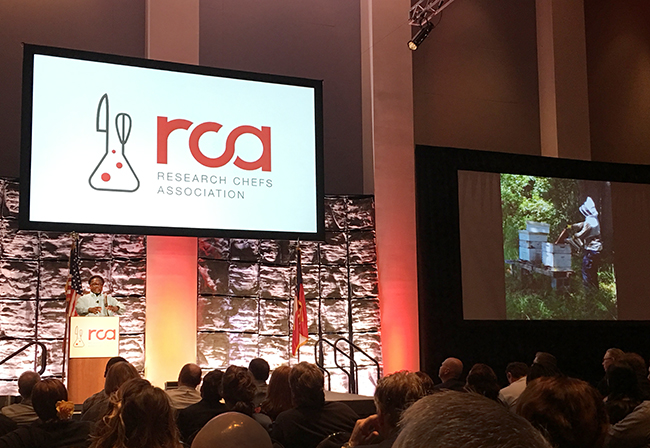The most-attended Research Chefs Association (RCA) conference to date, with more than 1,200 attendees and 140 exhibitors, this is where new product developers, food scientists and R&D chefs gather to find new solutions and insights for the year to come.
Nothing to Hide
Labeling laws will be updated to require added sugar on the front of packages in about 2-3 years, and the industry is moving away from artificial flavors and colors, too. But when using carrots as a coloring agent merits an artificial label, manufacturers are using front of the package logos to proclaim everything that’s both in and not in their products.
Trend Spotting
Veg-Centric is Not Meatless – veggies are no longer the supporting act to center of plate meat, but this isn’t a meatless mindset; proteins are produce partners and deliver big flavor with sausage and fish components on veg plates on trendy menus across the U.S.
Addressing Food Waste – byproducts are being used for culinary and functional fodder: pelletized flour as a byproduct of specialty oil production is being used in pastries and to smoke bourbon, while spent brewer’s grains are touted as having more protein than quinoa and more fiber than whole wheat in baked goods.
Convenience & Sustainability – it takes a lot of packaging and fuel to get convenience foods and restaurant-delivered foods to the end user; brands are starting with eco-friendly biofuels and recyclables.
Designing for Visual Appeal – social media is paving the way for new products to be designed for visual appeal over taste; such as the “unicorn frappuccino” that many claimed was too sweet to drink but had good sales due to its popularity on photo-sharing apps.
Customization via Technology – technology allows hyper-customization through mobile ordering; brands like Denny’s have tapped into the millennial consumer set when on-demand ordering launched, doubling off-premise sales with a fresh consumer base who hadn’t considered Denny’s to be an option previously.
Momentum toward Transparency
From beverage menus that provide various levels of sweetness that meet consumer tastes to flavor companies creating natural compounds that allow for clean label packaged goods, transparency is on trend. A recent Culinary Visions® Panel study found that 94% of consumers say they appreciate when a restaurant is honest about what they offer.
Implications for Food Marketers
More Food Processing – we already grow enough food to feed population growth projections for the coming decades; we need more food processing to solve the hunger crisis, and not less as some media outlets which demonize the industry claim.
Interconnected Trends – savvy product development incorporates multiple macro trends into product concepts from the start.
Technology Reaches – social can extend a brand beyond the walls it normally plays in, while misunderstood ingredients can generate hysteria among consumers who have little understanding of substances that are naturally present and can’t be stripped out; education and apt labeling is key.
Taste Talk Tweet
Twitter chatter included:
- Diverse proteins accent veg-centric menu items
- Eating insects may seem strange, but on a global scale, edible insects are ubiquitous: more than 2,000 different kinds of edible insects are consumed around the globe
- Innovative efforts to reduce food waste
Follow us on Twitter @Olsoncomm

